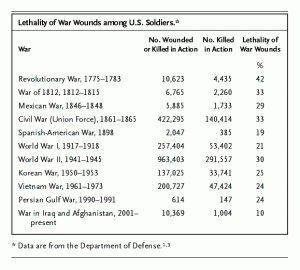CAM proponents are very fond of citing the antiquity and lineage, fictional or not, for their methods. Acupuncture, Traditional Chinese Medicine, and many herbal nostrums are promoted as “time-honored,” with the implication or explicit statement that anything people have been doing for so long must be a good thing. Foolishly expecting reason and logic to have some impact on this, we skeptics often try to point out that the number of people who believe something and the duration of time they believe it is not, unfortunately, a reliable indicator of whether or not it is BS. Or, as Tim Minchin more eloquently puts it in one of his songs, “I don’t believe that just because ideas are tenacious it means that they’re worthy.”
Soldiering on despite the blank stares or scoffing such a response often engenders, we continue to offer facts as rebuttal. The dramatic increase in life expectancy and health as scientific medicine came to replace traditional folk medicine seems a particularly salient fact in this context, but I recently ran across another smaller but more specific example of medical progress through time.
Dr. Atul Gawande, of Complications fame wrote an article for the New England Journal of Medicine in 2004 entitled Casualties of War–Military care for the wounded from Iraq and Afghanistan. As part of his discussion of care for wounded soldiers, he presented some historical statistics on the lethality of wounds suffered in combat by U.S. soldiers since the Revolutionary War. The table below illustrates the findings:
While we don’t have numbers from earlier eras or other countries, and while some caution is indicated in looking at numbers as old as those in the 18th and 19th centuries, the pattern is quite interesting. Survival varied, likely due in part to the reliability of the statistics, especially for small conflicts such as the Spanish-American War, but was consistently at or below 30% for most of the period until the 1950s. It improved to a consistent 25% for conflicts from then until the Iraq and Afghanistan conflicts and then improved dramatically. 90% of wounded soldiers can be expected to survive and come home, and while this raises legitimate questions about how we ensure they have an acceptable quality of life and adequate help dealing with the lasting effects of their injuries, very few of them over the long term will likely prefer to have died. In this limited sense, such a change represents true progress in medical care for these servicepeople.
Dr. Gawande doesn’t address the changes prior to the current wars, but it seems likely that the development of antibiotics, blood replacement products, and other crucial developments in trauma care are responsible for the improvement after WW II. Gawande does delve into the details of the changes in medical practices that have dramatically improved survival in the current conflicts.
The point from the perspective of the difference between traditional and science-based medicine is that 1) the improvement coincides with major developments in scientific medical care which are often dismissed as irrelevant or even sources of harm and 2) medical practices are constantly being re-evaluated and improved based on measurable results. This is in stark contrast to the claims of those who argue for faith in tradition and received ancient wisdom.
Traditional folk medical practices have indeed often been around for centuries or even millennia, though these claims are sometimes exaggerated or fabricated by CAM advocates. However, in all those centuries or millennia, these methods have never succeeded in making the improvements in survival and health that have come in the last two hundred years, as Enlightenment rationality and scientific medicine have been born and matured. And these traditional practices are founded on the perceived virtue of not changing, whereas the ability to change and adapt that science gives mainstream medicine is one of its greatest strengths. This paper provides a small but clear illustration of the general case that the virtues of the scientific method demonstrably provide better results than the claimed virtues of tradition and longevity often attached to alternative medical practices.










